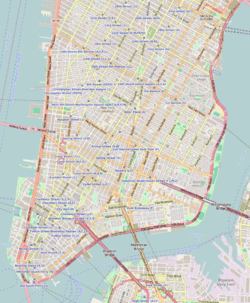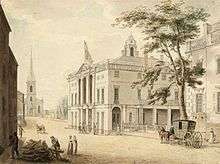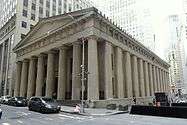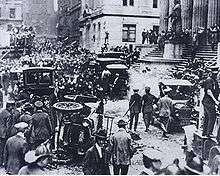Federal Hall
Federal Hall is a historic building at 26 Wall Street in the Financial District of Manhattan, New York City. The name refers to two structures on the site: a Federal style building completed in 1703, and the current Greek Revival-style building completed in 1842. While only the first building was officially called "Federal Hall", the current structure is operated by the National Park Service as a national memorial called the Federal Hall National Memorial.
Federal Hall National Memorial | |
U.S. National Memorial | |
New York City Landmark
| |
.jpg) Federal Hall National Memorial in 2006 | |
 Location of Federal Hall in New York City  Federal Hall (New York)  Federal Hall (the United States) | |
| Location | 26 Wall Street, Financial District, Manhattan, New York City |
|---|---|
| Coordinates | 40°42′26″N 74°0′37″W |
| Area | 0.45 acres (1,800 m2) |
| Built | May 26, 1842 |
| Architect | Town and Davis; John Frazee (Interior Rotunda) |
| Architectural style | Greek Revival |
| Visitation | 156,707 (2004) |
| Website | Federal Hall National Memorial |
| NRHP reference No. | 66000095[1] |
| Significant dates | |
| Added to NRHP | October 15, 1966[2] |
| Designated NMEM | August 11, 1955 |
| Designated NYCL | December 21, 1965[3] |
The original building served as New York's first City Hall. It was the site where the colonial Stamp Act Congress met to draft its message to King George III claiming entitlement to the same rights as the residents of Britain and protesting "taxation without representation". After the American Revolution, in 1785, the building served as meeting place for the Congress of the Confederation, the nation's first central government under the Articles of Confederation. With the establishment of the United States federal government in 1789, it was renamed Federal Hall, as it hosted the 1st Congress and was the place where George Washington was sworn in as the nation’s first president. It was demolished in 1812.
The current structure, one of the best surviving examples of Greek Revival architecture in New York City, was built as the U.S. Custom House for the Port of New York.[4] Later it served as a sub-Treasury building. The current national memorial commemorates the historic events that occurred at the previous structure.
History

First structure
The original structure on the site was built as New York's second City Hall in 1699 - 1703, on Wall Street, in what is today the Financial District of Lower Manhattan. In 1735, John Peter Zenger, an American newspaper publisher, was arrested for committing libel against the British royal governor and was imprisoned and tried there. His acquittal on the grounds that the material he had printed was true established freedom of the press as it was later defined in the Bill of Rights.[5]

In October 1765, delegates from nine of the 13 colonies met as the Stamp Act Congress in response to the levying of the Stamp Act by the Parliament of Great Britain. Drawn together for the first time in organized opposition to British policy, the attendees drafted a message to King George III, the House of Lords, and the House of Commons, claiming entitlement to the same rights as the residents of Britain and protesting the colonies' "taxation without representation".
After the American Revolution, the City Hall served as the meeting place for the Congress of the Confederation of the United States under the Articles of Confederation from 1785 until 1789. Acts adopted here included the Northwest Ordinance, which set up what would later become the states of Ohio, Indiana, Illinois, Michigan and Wisconsin, but more fundamentally prohibited slavery in these future states.
In 1788, the building was remodeled and enlarged under the direction of Pierre Charles L'Enfant,[6] who was later selected by President George Washington to design the capital city on the Potomac River. This was the first example of Federal Style architecture in the United States.
Federal Hall
The building was renamed Federal Hall when it became the nation’s first seat of government under the Constitution in 1789. The 1st Congress met there beginning on March 4, 1789, and George Washington was inaugurated as the first President of the United States on the balcony of the building on April 30, 1789.
Many of the most important legislative actions in the United States occurred with the 1st Congress at Federal Hall. Foremost was the proposal and initial ratification of the Bill of Rights to the U.S. Constitution; twelve amendments to the Constitution were initially drafted (ten were later adopted), and on September 25, 1789, the United States Bill of Rights was proposed in Federal Hall, establishing the freedoms claimed by the Stamp Act Congress on the same site 24 years earlier. In 1992 an eleventh of the initial 12 proposed amendments was adopted as the 27th Amendment. Also, the Judiciary Act of 1789 was enacted in the building, which set up the United States federal court system that is still in use today.
Second structure
Customs House and Treasury building
In 1790, the United States capital was moved to Philadelphia, and what had been Federal Hall once again housed the government of New York City until 1812, when the building was razed with the opening of the current New York City Hall.[7] Part of the original railing and balcony floor where Washington was inaugurated are on display in the memorial.[8] The current structure, one of the best surviving examples of Greek Revival architecture in New York, was built as the first purpose-built U.S. Custom House for the Port of New York.[4] Designed by architects Ithiel Town and Alexander Jackson Davis with a domed rotunda designed by the sculptor John Frazee, it was constructed of Tuckahoe marble and took more than a decade to complete. It opened in 1842.
In 1862, Customs moved to 55 Wall Street and the building served as one of six United States Sub-Treasury locations. Millions of dollars of gold and silver were kept in the basement vaults until the Federal Reserve Bank replaced the Sub-Treasury system in 1920.
In 1882, John Quincy Adams Ward's bronze Statue of George Washington was erected on its front steps, marking the approximate site where he was inaugurated as President in the former structure.
In the Wall Street bombing of 1920, a bomb was detonated across the street from Federal Hall at 23 Wall Street, in what became known as The Corner. Thirty-eight people were killed and 400 injured, and 23 Wall Street was visibly damaged, but Federal Hall received no damage. A famous photograph of the event shows the destruction and effects of the bombing with the statue of President Washington standing stoically in the face of chaos (see § Gallery).
Federal Hall National Memorial
The building was designated as Federal Hall Memorial National Historic Site on May 26, 1939, and redesignated a national memorial on August 11, 1955. Administered by the National Park Service, it was listed on the National Register of Historic Places on October 15, 1966. Federal Hall was designated a landmark by the New York City Landmarks Preservation Commission on December 21, 1965.[9]

On September 6, 2002, approximately 300 members of the United States Congress traveled from Washington, D.C. to New York to convene in Federal Hall National Memorial as a symbolic show of support for the city, still recovering from the September 11, 2001 attacks. Held just four blocks from the former World Trade Center's Twin Towers, the meeting was the first by Congress in New York since 1790.[7]
The site closed on December 3, 2004, for an extensive $16 million renovation, mostly to its foundation, after cracks threatening the structure were greatly aggravated by the collapse of the World Trade Center. In 2006, Federal Hall National Memorial reopened.[10]
It was reported on June 8, 2008, that New York City Mayor Michael Bloomberg and ABC News invited 2008 United States presidential candidates John McCain and Barack Obama to a town hall forum at Federal Hall.[11] Both candidates declined the offer "because they do not want it limited to one television network."[12]
The National Park Service operates Federal Hall as a national memorial. As a national memorial, the site is open free to the public from 9 a.m. to 5 p.m. on weekdays. It has tourist information about the New York Harbor area's federal monuments and parks, and a New York City tourism information center. The gift shop has colonial and early American items for sale. Normally its exhibit galleries are open free to the public daily, except national holidays, and guided tours of the site are offered throughout the day. Exhibits include George Washington’s Inauguration Gallery, including the Bible used to swear his oath of office; Freedom of the Press, the imprisonment and trial of John Peter Zenger; and New York: An American Capital, preview exhibit created by the National Archives and Records Administration.
Architecture

Two prominent American ideals are reflected in the current building's Greek Revival architecture: The Doric columns of the facade, designed by Ithiel Town and Alexander Jackson Davis, resemble those of the Parthenon and serve as a tribute to the democracy of the Greeks; the domed ceiling inside, designed by John Frazee, echoes the Pantheon and is evocative of the republican ideals of the ancient Romans.[2]
The current structure is often overshadowed among downtown landmarks by the New York Stock Exchange, which is located diagonally across Wall and Broad Streets, but the site is one of the most important in the history of the United States and, particularly, the foundation of the United States government and its democratic institutions.
On U.S. postage

Engraved renditions of Federal Hall appear twice on U.S. postage stamps. The first stamp showing Federal Hall was issued on April 30, 1939, the 150th anniversary of President Washington's inauguration, where he is depicted on the balcony of Federal Hall taking the oath of office.
The second issue was released in 1957, the 200th anniversary of Alexander Hamilton's birth. This issue depicts Alexander Hamilton and a full view of Federal Hall.[13][14]
Access
Federal Hall is open from 9 a.m. to 5 p.m. on Mondays through Fridays, and is closed on Sundays and Saturdays. The monument is compliant with the Americans with Disabilities Act of 1990 via a ramp at its rear. The M55 bus stops nearby on Broadway, while the M15 and M15 SBS stop nearby on Water Street. In addition, the Broad Street station of the New York City Subway, serving the J and Z trains, is directly under Federal Hall.[15]
Gallery
 View from north
View from north- The George Washington Inaugural Bible, on which Washington took his inaugural oath in 1789
- Brass relief of Washington kneeling in prayer.
- Plaque commemorating the Northwest Ordinance and the establishment of the state of Ohio
 The 1920 Wall Street bombing, with the sub-treasury building in the background at right
The 1920 Wall Street bombing, with the sub-treasury building in the background at right
References
Notes
- "National Register Information System". National Register of Historic Places. National Park Service. March 13, 2009.
- "Federal Hall National Memorial". National Park Service. Retrieved June 25, 2016.
- "Federal Hall National Memorial" (PDF). New York City Landmarks Preservation Commission. December 21, 1965. Retrieved June 25, 2016.
- "Federal Hall -- U.S. Custom House". FEDERAL HALL. Retrieved October 25, 2016.
- "The Trial of John Peter Zenger". nps.gov.
- "The Story of a Street".
- "Inside Politics: Symbolic Site for Congress to Meet". cnn.com. September 5, 2002. Archived from the original on November 20, 2017. Retrieved August 27, 2019.
- "Inaugural Balcony". nps.gov.
- http://www.neighborhoodpreservationcenter.org/db/bb_files/FEDERAL-HALL-ORIGINAL.pdf
- "National Archives Announces Major Venue in New York City". National Archives. December 14, 2006. Retrieved August 30, 2019.
- ABC News. "New York Mayor, ABC News Invite Obama, McCain to Historic Town Hall". ABC News.
- https://news.yahoo.com/s/ap/20080608/ap_on_el_pr/bloomberg_town_hall
- "The Presidents". The White House.
- Scott's US Stamp Catalogue
- "Basic Information - Federal Hall National Memorial (U.S. National Park Service)". www.nps.gov. Retrieved August 15, 2019.
Sources
- The National Parks: Index 2001–2003. Washington: U.S. Department of the Interior.
External links
| Wikimedia Commons has media related to Federal Hall. |
- Official NPS website: Federal Hall National Memorial
- Federal Hall
- National Parks of NY Harbor Conservancy: Federal Hall Visitor Information
- Manhattan Historic Sites Archive: Federal Hall
- Library of Congress - The New Capital City
- U. S. Custom House, 28 Wall Street, New York, New York, NY, Historic American Buildings Survey
- Engraving: Federal Hall, The Seat of Congress
- Lithograph: A View of the Federal Hall, 1797

